Robotics and AI (Artificial Intelligence) are two revolutionary technologies that are changing the automation landscape. Together, they forge a potent synergy that transforms industries and heralds the arrival of cutting-edge automation solutions in the future. In this in-depth investigation, we’ll examine how AI and robotics interact, their existing applications in society, the tremendous advantages they provide, and the fascinating prospects that lie ahead.
Understanding AI and Robotics:
AI (Artificial Intelligence): The creation of computer systems capable of carrying out tasks requiring human-like intelligence is referred to as artificial intelligence. This includes a broad range of abilities, such as artificial intelligence, computer vision, natural language processing, and decision-making. AI systems generate predictions or choices based on patterns and insights after learning from data and adapting to new information.
Robotics: Robotics focus on creating real, mechanical devices known as robots that can interact with the real world. These devices have sensors, actuators, and frequently AI-driven software, and they can be controlled autonomously or semi-autonomously. Robotics combines mechanics, electronics, and software to produce adaptable machines that can carry out a wide range of activities.

The Synergy of AI and Robotics:
The cognitive skills of AI and the mechanical abilities of robots are combined in a powerful way by the synergy between AI and robotics. Here is how this collaboration operates:
- Enhanced Perception and Sensing: AI equips robots with advanced perception capabilities. Computer vision, combined with sensor technologies, allows robots to understand and interpret their environment. They can recognize objects, assess distances, and make decisions based on real-time data.
- Intelligent Decision-Making: AI enables robots to make smart decisions by processing large amounts of data quickly. Machine learning algorithms empower robots to adapt to changing conditions and optimize their actions, increasing efficiency and productivity.
- Human-Robot Collaboration: AI-driven robots can collaborate safely with humans. They can understand human gestures, respond to voice commands through natural language processing, and work alongside humans in shared spaces, enhancing overall productivity.
- Automation in Healthcare: The healthcare sector benefits from AI-powered robots that aid surgeons during delicate procedures. These robots offer precision and stability, leading to minimally invasive surgeries and quicker patient recovery. Additionally, AI-driven robots can assist in patient care, monitoring vital signs, and medication administration.
- Logistics and Warehousing Optimization: In logistics and warehousing, AI and robotics optimize operations. Robots with AI algorithms can autonomously manage inventory, streamline order fulfillment, and navigate complex warehouse layouts. This reduces human labor, enhances accuracy, and speeds up order processing.
- Agricultural Advancements: AI-powered robots find applications in agriculture, monitoring crop health, planting seeds, applying fertilizers, and harvesting crops autonomously. This leads to increased crop yields, reduced resource usage, and sustainable farming practices.
- Customization and Personalization: AI-driven robotics drives customization in manufacturing. These systems efficiently produce personalized products, catering to individual customer preferences. This level of personalization is increasingly valuable in industries like automotive, fashion, and consumer electronics.
Continuous Learning and Adaptation: AI enables robots to learn and adapt continuously. They can tackle new tasks and environments with ease, making them invaluable in dynamic settings, such as disaster response, where quick adjustments are essential.

The Benefits of AI and Robotics Synergy:
Now that we understand how AI and Robotics work together, let’s explore the myriad benefits they offer:
- Increased Efficiency: AI-driven robots work tirelessly and consistently, reducing errors and improving task completion times. This boosts efficiency across industries, from manufacturing to logistics.
- Precision and Accuracy: Robots equipped with AI make fewer mistakes, particularly in tasks that require precision, such as surgeries or complex manufacturing processes.
- Safety and Risk Reduction: In hazardous environments or high-risk situations, AI-powered robots can replace or assist humans, minimizing danger and potential harm.
- Cost Savings: Over time, investments in AI and Robotics can lead to significant cost savings by reducing labor costs, improving resource management, and minimizing waste.
- 24/7 Availability: Robots don’t need breaks, sleep, or vacations. They can operate around the clock, ensuring continuous productivity.
- Scalability: Businesses can scale their operations efficiently by adding more robots as needed, without the complexities of hiring and training additional human workers.
- Customization: AI-driven robots excel at producing customized products, allowing businesses to meet the unique needs and preferences of their customers.
- Data-Driven Insights: AI processes vast amounts of data, providing valuable insights for decision-making and process optimization.
- Improved Healthcare: AI and Robotics are advancing healthcare by enhancing surgical precision, providing telemedicine solutions, and assisting with patient care.
- Environmental Sustainability: In agriculture and other industries, AI and Robotics can reduce resource wastage, minimize environmental impact, and promote sustainable practices.

AI and Robotics are already transforming various sectors. Here are some notable examples of their current implementations:
- Manufacturing: Industrial robots equipped with AI handle tasks like welding, painting, and assembly in automotive and electronics manufacturing plants. Collaborative robots work alongside human workers, improving efficiency and safety.
- Logistics: Autonomous delivery robots and drones are used for last-mile delivery, while AI-powered systems manage warehouse operations for e-commerce giants like Amazon.
- Healthcare: Robotic surgical systems like the da Vinci Surgical System assist surgeons in performing intricate surgeries. AI also aids in medical diagnosis and treatment planning.
- Agriculture: Autonomous tractors and drones equipped with AI monitor crop health, apply pesticides, and harvest crops with precision.
- Service Industry: Robots are employed in the service sector, such as in hotels and restaurants, where they can perform tasks like cleaning and food preparation.
- Space Exploration: AI-driven robots and rovers are essential for space exploration missions, collecting data, and conducting experiments on celestial bodies.
- Home Automation: AI-powered smart home devices, including robotic vacuum cleaners and voice-activated assistants like Amazon’s Alexa and Google Assistant, have become commonplace.

The Future with AI and Robotics:
The future holds immense potential for AI and Robotics. Here’s what we can expect:
- More Autonomous Systems: AI-driven robots will become increasingly autonomous, capable of making complex decisions without human intervention. This will revolutionize industries like transportation, where self-driving cars and trucks will become more common.
- Enhanced Human-Robot Collaboration: Collaborative robots (cobots) will continue to improve, fostering safer and more efficient cooperation between humans and robots in workplaces.
- AI-Powered Personalization: Customization and personalization will reach new heights, with AI-driven robots tailoring products and services to individual preferences.
- Healthcare Advancements: AI and Robotics will continue to advance healthcare, with the potential for remote surgeries and AI-powered diagnostics becoming more prevalent.
- Environmental Impact: AI and Robotics will play a pivotal role in addressing environmental challenges, such as climate change, by optimizing resource usage and promoting sustainable practices.
- Education and Research: Robots equipped with AI will assist in education and research, aiding students in learning and scientists in conducting experiments in challenging environments.
- Ethical Considerations: As AI and Robotics become more integrated into society, ethical concerns around accountability, data privacy, and job displacement will require careful consideration and regulation.rh

In conclusion, a new era of automation and innovation is being ushered in by the synergy between AI and robotics. These technologies are already altering industries and improving the convenience and effectiveness of our daily lives. The possibilities are endless as they develop, indicating a future in which AI-powered robots are essential to both our daily lives and the global economy. To ensure that AI and robotics are beneficial to humans, it is necessary to navigate this future responsibly, considering ethical, legal, and societal concerns.
